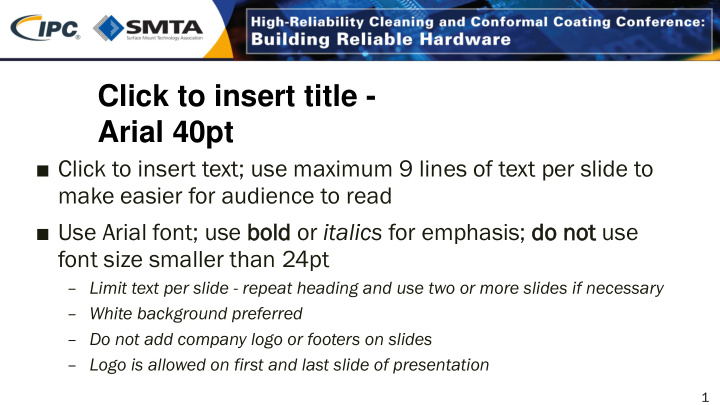



Click to insert title - Arial 40pt ■ Click to insert text; use maximum 9 lines of text per slide to make easier for audience to read ■ Use Arial font; use bo bold ld or italics for emphasis; do not use font size smaller than 24pt – Limit text per slide - repeat heading and use two or more slides if necessary – White background preferred – Do not add company logo or footers on slides – Logo is allowed on first and last slide of presentation 1
Outline ■ Introduction ■ Particle removal ■ Static Environment ■ EOS consideration ■ Case Study ■ Conclusions 2
■ INTRODUC ODUCTI TION ON 3
■ Zero defects – Zero rework Defects found during manufacture and test Latent defects 4
Major Causes of defects ■ Particles on the board before solder paste ■ Damage causes by static electricity (ESD) to components and fine tracks 5
■ PARTICL ICLE E REM EMOVAL 6
Particles ■ Teknek’s SMT contact cleaner has been used for many years to efficiently remove particles and increase yields 7
Areas ■ SMT2017 in the SMT Process – Clean before solder paste print – Clean after laser marking Technology 8
9
■ STATIC TIC EN ENVIRONM NMENT ENT 10
Teknek SMT Machine and static charge 11
ANSI ESD S20.20 ■ All components which touch the PCB during processing must have a Surface Resistance less than 10 9 Ohms ■ Impedance to ground must be less than 1 XXXX ■ All non-essential insulators must be removed ■ Maximum electric field strength is 125V/25mm 12
Implementation of ANSI ESD S20.20 ■ Removal of non-essential insulators ■ Innovative grounding for rollers ■ Reformulation of Nanocleen ■ Redesign of Adhesive 13
Removing Non-Essential Insulators Existing Perspex Window New Metal Window 14
Innovative Grounding ■ Challenge: rollers both have to rotate and to be pulled out of machine 15
Tribocharging ■ Silicone rollers: -120nC/J ■ Nanocleen Rollers: +40nC/J ■ Pressure sensitive adhesive: -10nC/J ■ Epoxy Printed Circuit board: -32nC ■ Silicone/ Adhesive Triboelectric gap: 110nC/J ■ Silicone/ PCB Triboelectric gap: 88nC/J ■ Nanocleen/ Adhesive Triboelectric gap: 50nC/J ■ Nanocleen/PCB Triboelectric gap:72nC/J 16 Measurement Ref: www.alphalabinc.com/triboelectric-series/
Reducing Tribocharging ■ Included additives in the formulation to reduce the tribocharging potential of the elastomer and therefore the amount of charge generated ■ Increased shore hardness of elastomer rollers to reduce contact area between the rollers and the board and between the rollers and the Adhesive surface ■ Reformulated the elastomer to increase its conductivity 17
Results 30v 30v 90V 80V 30v 10V 10V 30v 18
Verification 19
■ EO EOS Con S Conside ideration ation 20
Next stage – Electrical Overstress 21
ESD vEOS ESD discharge component failure Fail / dead EOS Event - Potential latent Latent failure Component threshold damage OK 22
EOS Mitigation ■ In addition to the measures taken for ANSI ESD S20.20 ■ Adding Nanoparticle additives to standard elastomer rollers to give high conductivity ■ Altering the adhesive material to give increased conductivity ■ Reformulating the adhesive to reduce the adhesive forces between the adhesive and the Elastomer rollers reducing the tribocharging ■ Removing the static bar from the exit of the machine to reduce the risk of induced current 23
Results 30v 30v 30v 30v 24
■ Cas ase e Stu tudy dy 25
Case Study ■ Major Scandinavian Automotive electronics Manufacturer ■ Issue: Blowing of LED’s during second side cleaning when using a Teknek SMT machine with conventional elastomer rollers and adhesive. ■ Tried the ANSI ESD S20.20 verified machine and the issue disappeared but still had a concern about static levels ■ Tested the latest developments, including removal of the static bars and decided to implement the new equipment upgrade to their Teknek machines in facilities across the world. 26
27
Conclusions ■ Through careful design and material developments Teknek have overcome the challenges of Tribocharging in Contact cleaning to produce a very low static environment within their machine. ■ This development also removes the necessity to have static bars after the machine. ■ Together this not only significantly reduces the risk of ESD but also mitigates any potential for EOS caused by induced current in the connectors passing through any electric field within the equipment ■ The combination of the highest efficiency particle cleaning with negligible ESD/EOS risk provides assemblers with the highest reliability cleaning method for boards prior to solder paste application 28
Recommend
More recommend